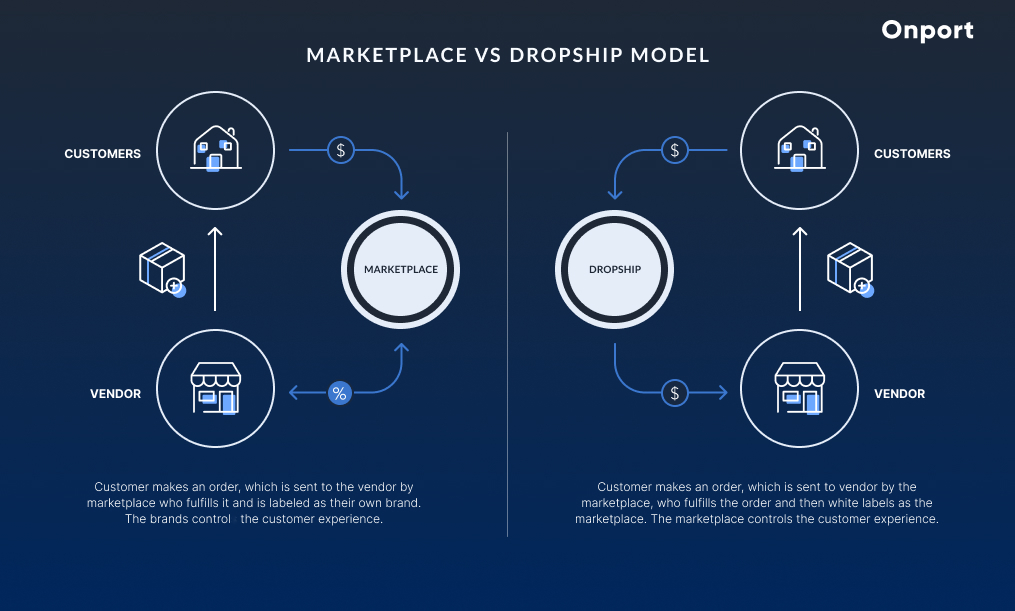What is a Multi Vendor Marketplace?

The Marketplace Revolution
Online Marketplaces. They represent an ever-growing segment within the ecommerce space, which is quickly establishing itself as the most dominant in terms of market share - some 57% of all global ecommerce is enabled through the top 100 marketplaces. In the US alone, for example, retail marketplace sales represent over one-third of all retail e-commerce sales and are expected to grow by over 10% year over year from $385 billion in 2023 to $603.2 billion in 2027, according to Insider Intelligence.
While many immediately think of ecommerce giants such as eBay or Amazon as the most prominent examples of the multi vendor marketplace model in practice, there has been a rising segment known as the curated marketplace model in which vendors and brands are carefully selected to ensure they align with the brand ethos and value proposition of the hosting marketplace. These marketplaces are experiencing a particular growth.
An example would be a sustainable fashion marketplace, ensuring that those companies who list on its platform conform to the principles of sustainability.
The Concept
A multi vendor marketplace is an online platform or website where multiple independent vendors can list and sell their products. Instead of being operated by a single entity selling its own products, a multi vendor marketplace allows various third-party vendors to list their products on its platform.

Often, this involves a curation process, ensuring that the brand aligns with the company values and the targeted customer segment. A marketplace may only choose to list specific items from a vendor's product catalog. An online marketplace can be thought of as essentially a digital shopping mall.
Operating Models
In terms of operations, there are generally three different types of models that an online marketplace may choose to adopt, depending on its particular requirements and resources to hand.
These are called Dropship, Marketplace, or a combination of both, known as the Hybrid model. While there are similarities within each model, there are some core differences.
Dropship
Dropship is a type of fulfillment model in which a Retailer lists a range of products for sale on their online marketplace without physically holding the inventory. This lowers inventory risk and associated costs, such as shipping and warehousing.
When a purchase is made, the customer's order is routed back to the vendor by the Retailer who purchases the product. The vendor then ships the item straight to the customer on behalf of the Retailer, often white labeled as the original marketplace, for a seamless delivery experience. The end customer may or may not be made aware of the 3rd party nature of the fulfillment process.
The retailer controls the product pricing displayed on its site instead of the vendor, meaning it can keep a solid profit margin on the cost of the products on its site. Under a dropship arrangement, the retailer generally retains greater control over all customer touchpoints, including customer support, although this can be subject to a specific agreement with the end vendor.

Marketplace
Similar to a dropship arrangement above, the retailer collects the payment and then passes the order onto the vendor, which then deals with delivery but is often branded as itself, not the marketplace. Some retailers may choose to hold some inventory on their end, such as their own branded items.
The vendor will be given more control over how their products are displayed, including branding, pricing, and product listings. As the price for placement on the marketplace, these brands will then generally pay a commission percentage on their sales to the retailer.
Under a marketplace model arrangement, the customer is often aware that their order will be fulfilled by the end vendor and not the platform on which they made their purchase. Therefore, it is generally the vendor who will handle customer service needs.
Hybrid Model
The hybrid model is where a marketplace may choose to blend fulfillment methods to handle different vendor relationships, such as holding some inventory itself or a blend of the two models above.
You can find out more about these operation models via our article - How Do The Dropship & Marketplace Models Work?.
Value Proposition
Marketplaces offer several advantages over standard ecommerce models for retailers. These can include:
Unified Shopping Experience
One of the core value propositions of a multi vendor marketplace, regardless of model, is that it offers the customer a more unified shopping experience in the form of an expanded product range, as well as often having products at a more affordable price.
Product Catalog Expansion
The dropship model can allow retailers to onboard new vendors and products much faster and with a much lower risk profile than more traditional approaches. For instance, the retailer can trial new products, and if they fail to sell in enough volume, they are not burdened with low-demand inventory that will only decrease in value over time.
Brand Credibility
Having specific products featured on a more established retailer's marketplace can boost brand credibility to the end consumer. If a retailer chooses to stock a vendor's products, it can help lend credibility to that company and elevate its brand profile. In many cases, customers can leave reviews and ratings for products, providing transparency and aiding other customers in making informed purchasing decisions.
Operations
Generally, an online marketplace will involve five main workflows regarding day-to-day operations.
Inventory Management
This is how the marketplace manages its inventory, what products are in stock, which are sold out or unavailable, and the pricing and product information data. It's vital that inventory is managed in real-time.
Order Routing
Once an order is placed, it is then sent back to the end vendor for fulfillment. This is a core element of any ecommerce business. Depending on the individual setup of the marketplace, orders may be split into different fulfillment flows between vendors or in-house.
Shipping Workflows
Depending on the particular agreement reached with the vendor, the marketplace will need to have some level of oversight over the current status of each order and the choice of carrier involved. They will also need to provide tracking information to the end customer to help coordinate the delivery experience.
Payments & Commission Rates
Depending on the particular model in use and the agreement reached, the Retailer needs to have clear oversight on the different commissions due to the vendors and any outstanding payments to be made to them.
Returns Management
Returns can be one of the most important and challenging aspects of running a successful online marketplace ecommerce platform. Many online shoppers regard a favorable returns policy as being a key deciding factor as to whether they will buy from a Retailer.
Technology
To support the growth of online marketplaces, there has been an accompanying growth in technology solutions that are designed to automate the processes above and facilitate the marketplace itself, either through front-end integration, backend integration, or a combination of both.
Marketplace software can include an all-in-one solution, where all aspects, both front and backend elements, are contained within a single package, or they may focus only on either the front or backend.
Such solutions can operate through integrations between different 3rd party solutions, such as payment gateways or shipping carriers.

Flexibility
Due to the rapidly changing nature of ecommerce, as well as increasing dynamic macro-environmental factors, there is an increasing requirement for flexibility. Retailers are increasingly searching for new revenue streams, which the dropship and marketplace models can provide. The ability to pivot quickly using these models can be key to their successful implementation.
Composable Commerce
A rising topic within ecommerce is known as Composable Commerce. This is a developmental software concept, with decoupling of the front and back ends instead of an all-in-implementation. This process can help prevent what is known as vendor lock-in, where a solution may become restrictive as the business scales.

Using composable marketplace software, users can choose which components to integrate into their stack. Such a modular approach emphasizes flexibility in the development process and allows ecommerce companies to pivot faster in the face of both opportunities and challenges. You can find out more about composable commerce here.
Onport
Onport is an Ecommerce Marketplace and Dropshipping Platform enabling companies to centralize the core areas of backend marketplace dropshipping operations using next-generation composable technology - inventory syncing, order routing, shipping workflows, payment automation and returns management.
“With Onport, we could launch in less than three months, which we just couldn’t have done had we built the system ourselves.”
Frank A. Ricciardi | Founder & CEO Maavee
Over 200+ companies in the e-commerce space are future-proofing their business with a solution trusted by brands such as Stadium Goods, Airstream, Cupra, Ivalo, and Naduvi.
